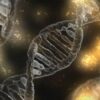The complexity of living organisms is encoded within their genes, but where do these genes come from? Researchers at the University of Helsinki resolved outstanding questions around the origin of small regulatory genes, and described a mechanism that creates their DNA palindromes. Under suitable circumstances, these palindromes evolve into microRNA genes.
The human genome contains ca. 20,000 genes that are used for the construction of proteins. Actions of these classical genes are coordinated by thousands of regulatory genes, the smallest of which encode microRNA molecules that are 22 base pairs in length. While the number of genes remains relatively constant, occasionally, new genes emerge during evolution. Similar to the genesis of biological life, the origin of new genes has continued to fascinate scientists.
All RNA molecules require palindromic runs of bases that lock the molecule into its functional conformation. Importantly, the chances of random base mutations gradually forming such palindromic runs are extremely small, even for the simple microRNA genes.
Hence, the origin of these palindromic sequences has puzzled researchers. Experts at the Institute of Biotechnology, University of Helsinki, Finland, resolved this mystery, describing a mechanism that can instantaneously generate complete DNA palindromes and thus create new microRNA genes from previously noncoding DNA sequences.
In their project, the researchers studied errors in DNA replication. Ari Löytynoja, the project leader, compares DNA replication to typing of text.
“DNA is copied one base at a time, and typically mutations are erroneous single bases, like mis-punches on a laptop keyboard. We studied a mechanism creating larger errors, like copy-pasting text from another context. We were especially interested in cases that copied the text backward so that it creates a palindrome.”
Researchers recognized that DNA replication errors could sometimes be beneficial. They described these findings to Mikko Frilander, an expert in RNA biology. He immediately saw the connection to the structure of RNA molecules.
“In an RNA molecule, the bases of adjacent palindromes can pair and form structures resembling a hairpin. Such structures are crucial for the function of the RNA molecules,” he explains.

A central insight was to model the gene history using information from related species. The modeling demonstrated that the palindromes of microRNA genes are generated by single mutation events. © Ari Löytynoja
Researchers decided to focus on microRNA genes due to their simple structure: the genes are very short—just a few tens of bases—and they have to fold into a hairpin structure to function correctly.
A central insight was to model the gene history using a custom computer algorithm. According to postdoctoral researcher Heli Mönttinen, this enables the closest inspection of the origin of genes thus far.
“The whole genome of tens of primates and mammals is known. A comparison of their genomes reveals which species have the microRNA palindrome pair and which lack it. With a detailed modeling of the history, we could see that whole palindromes are created by single mutation events,” says Mönttinen.
By focusing on humans and other primates, researchers in Helsinki demonstrated that the newly found mechanism can explain at least a quarter of the novel microRNA genes. As similar cases were found in other evolutionary lineages, the origin mechanism appears universal.
In principle, the rise of microRNA genes is so easy that novel genes could affect human health. Heli Mönttinen sees the significance of the work more broadly, for example, in understanding the basic principles of biological life.
“The emergence of new genes from nothing has fascinated researchers. We now have an elegant model for the evolution of RNA genes,” she highlights.
Although the results are based on small regulatory genes, researchers believe that the findings can be generalized to other RNA genes and molecules. For example, by using the raw materials generated by the newly found mechanism, natural selection may create much more complex RNA structures and functions.
The study was published in Proceedings of the National Academy of Sciences.
More information:
Heli A. M. Mönttinen et al, Generation of de novo miRNAs from template switching during DNA replication, Proceedings of the National Academy of Sciences (2023). DOI: 10.1073/pnas.2310752120
Provided by
University of Helsinki
Citation:
New genes found that can arise ‘from nothing’ (2023, December 8)



